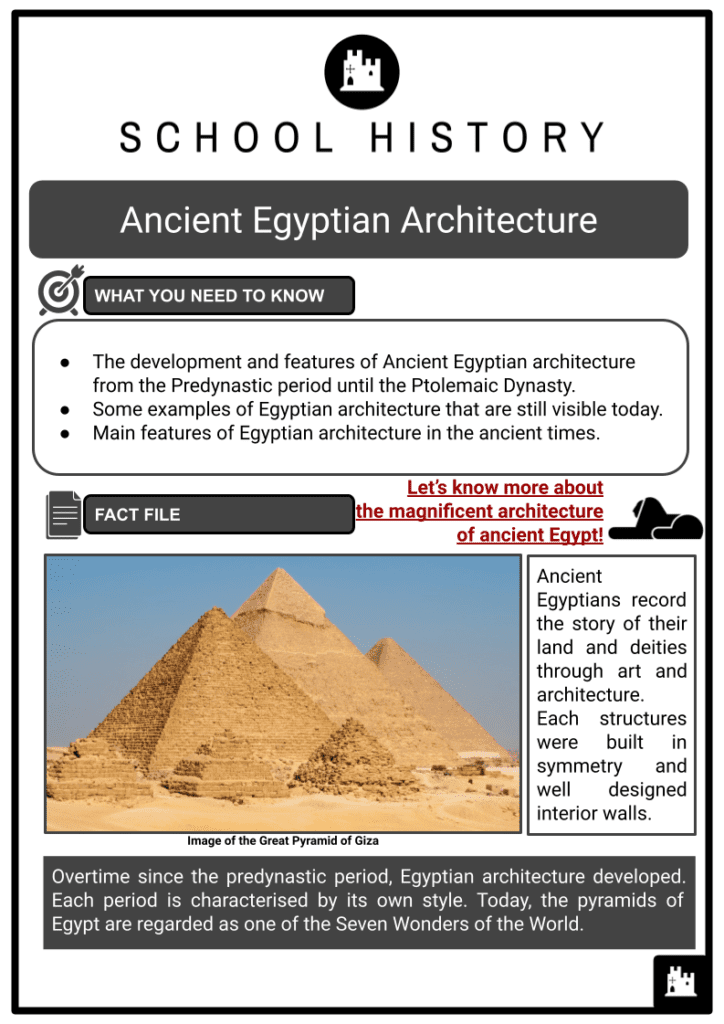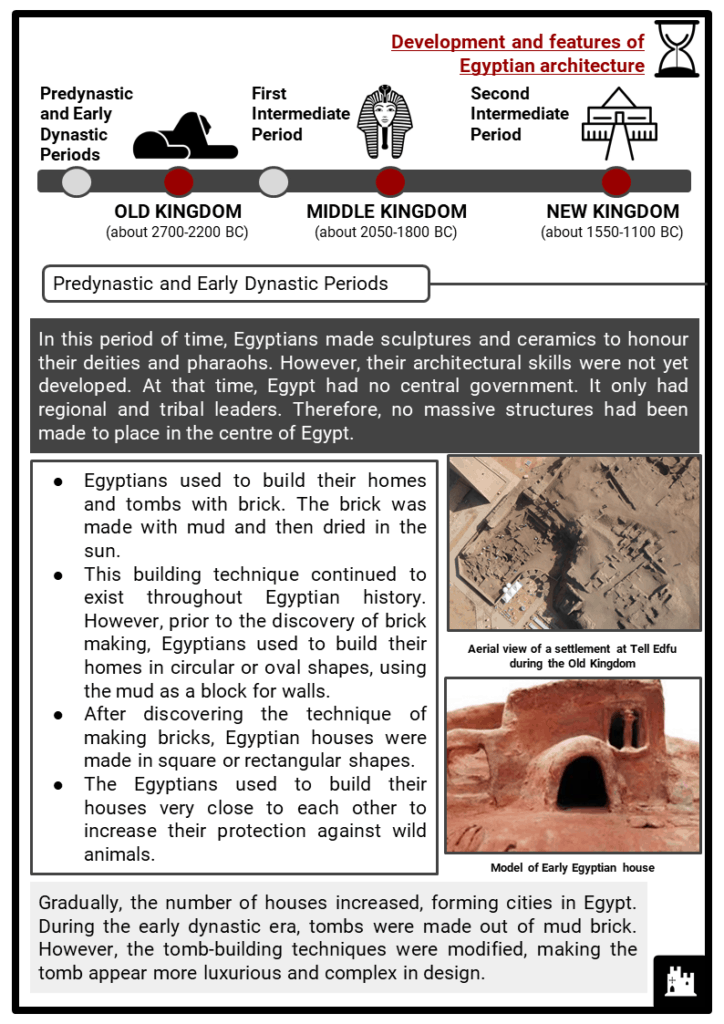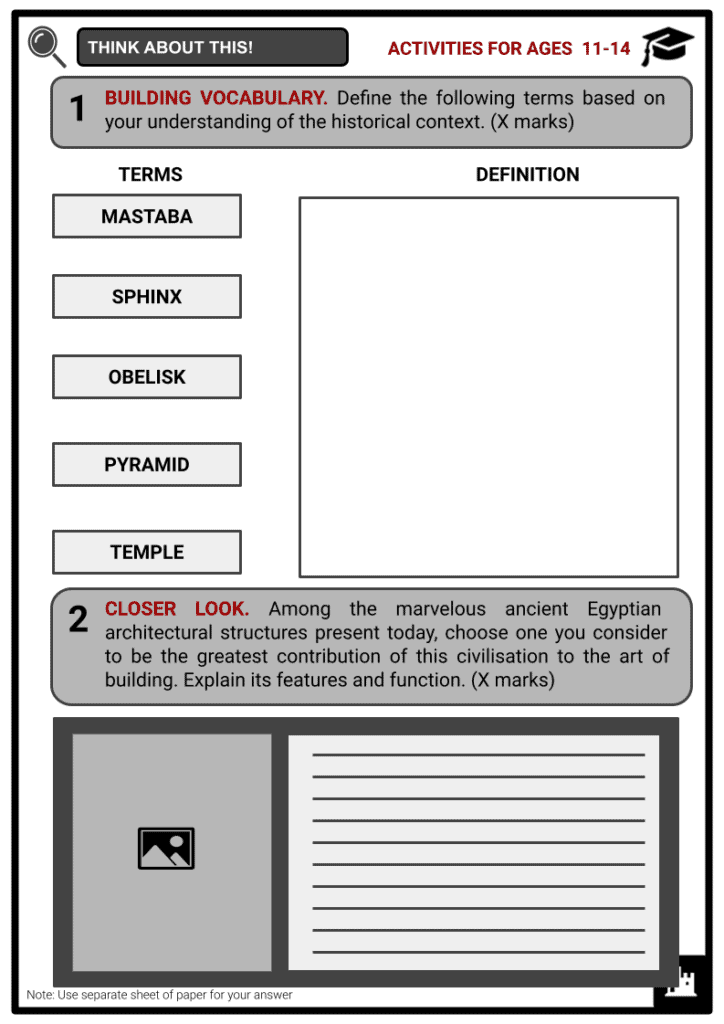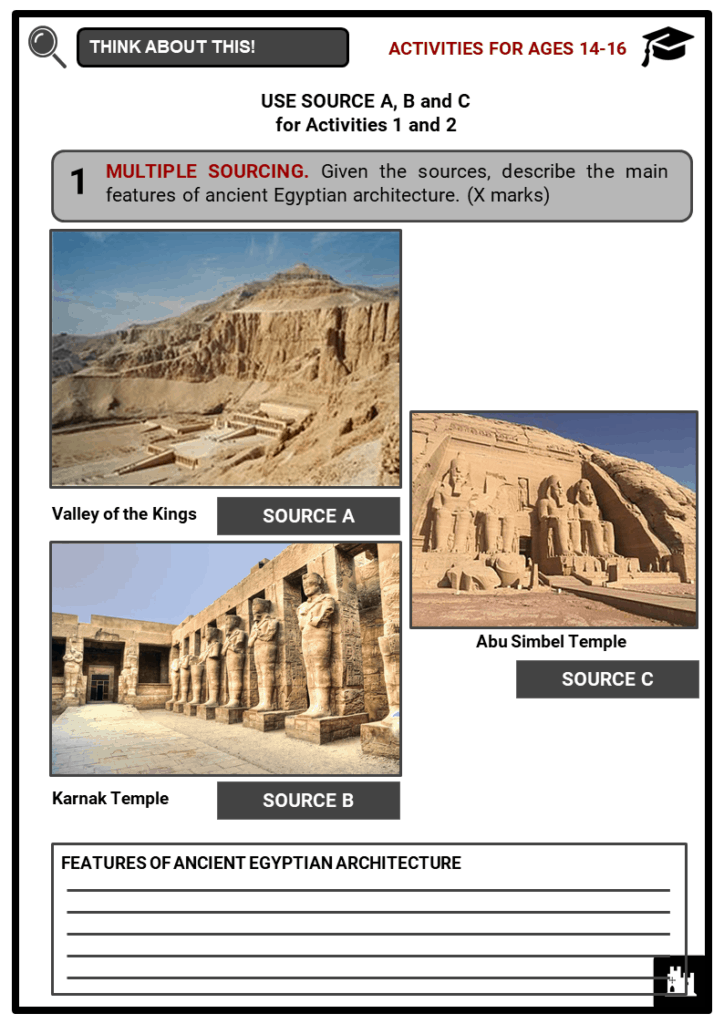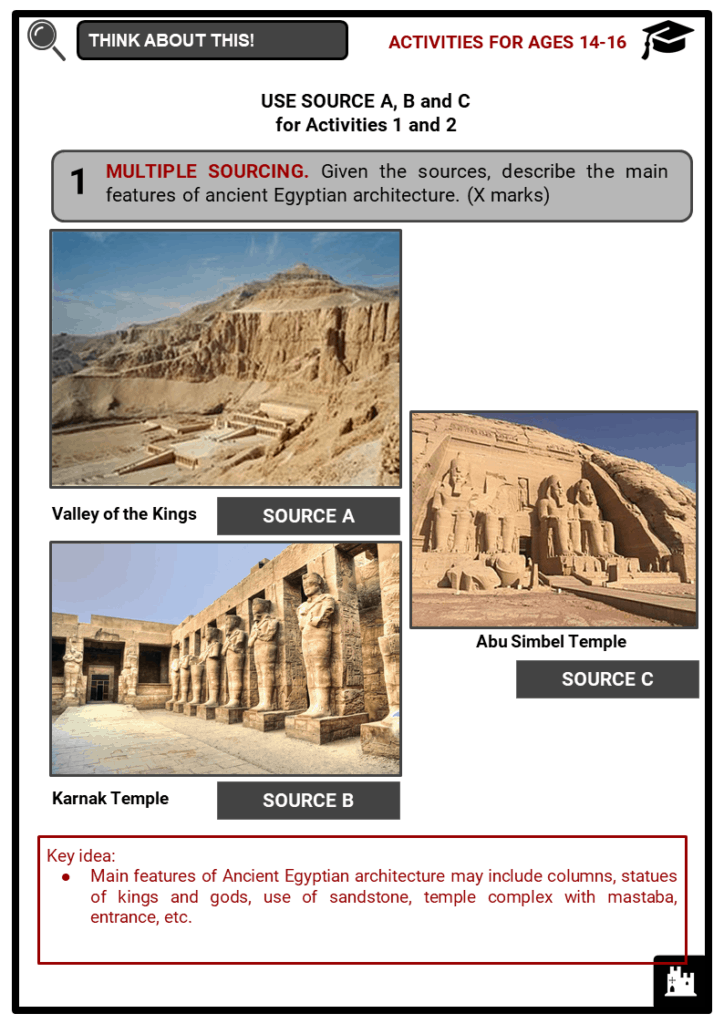Download Ancient Egyptian Architecture Worksheets
Do you want to save dozens of hours in time? Get your evenings and weekends back? Be able to teach Ancient Egyptian Architecture to your students?
Our worksheet bundle includes a fact file and printable worksheets and student activities. Perfect for both the classroom and homeschooling!
Table of Contents
Add a header to begin generating the table of contents
Summary
- The development and features of Ancient Egyptian architecture from the Predynastic Period until the Ptolemaic Dynasty
- Some examples of Egyptian architecture that are still visible today
- Main features of Egyptian architecture in ancient times
Key Facts And Information
Let’s learn more about the magnificent architecture of ancient Egypt!
- Ancient Egyptians recorded the story of their land and deities through art and architecture. Each structure was built symmetrically and with well designed interior walls.
- Since the Predynastic Period, Egyptian architecture has continually developed. Each period is characterised by its own style. Today, the pyramids of Egypt are regarded as one of the Seven Wonders of the World.
Development and features of Egyptian architecture
Predynastic and Early Dynastic Periods
- In this period of time, Egyptians made sculptures and ceramics to honour their deities and pharaohs. However, their architectural skills were not yet developed. At that time, Egypt had no central government. It only had regional and tribal leaders. Therefore, no massive structures had been made to place in the centre of Egypt.
- Egyptians used to build their homes and tombs with brick. The brick was made with mud and then dried in the sun.
- This building technique continued to exist throughout Egyptian history. However, prior to the discovery of brick making, Egyptians used to build their homes in circular or oval shapes, using the mud as a block for walls.
- After discovering the technique of making bricks, Egyptian houses were made in square or rectangular shapes.
- The Egyptians used to build their houses very close to each other to increase their protection against wild animals.
- Gradually, the number of houses increased, forming cities in Egypt. During the early dynastic era, tombs were made out of mud brick. However, the tomb-building techniques were modified, making the tomb appear more luxurious and complex in design.
- Stone monuments began to appear in the Second Dynasty of Egypt (c. 2890 - c. 2670 BCE). One of the first stone monuments was called an obelisk, or teknuhu in Egyptian.
- Unlike Assyrian and Mesoamerican cultures, which also built such kinds of stone monuments, the Egyptians used monolithic stone. More specifically, they used red granite most of the time.
- The term teknuhu means ‘to pierce’, specifically ‘to pierce the sky’.
- For the ancient Egyptians, obelisks represented the benben of god Amun, who created the world. Later in the New Kingdom, such monuments were popularly associated with Ra and the worship of the sun.
- During the reign of Djoser, Imhotep, probably the most famous vizier in Egyptian history, constructed the great mastaba tomb for his king. Resembling a pyramid, the tomb was actually made of a series of stacked mastabas, which came to be known as a step pyramid. This work became the reference of the iconic step design in Egyptian architecture.
- Stonework was an increasingly popular technique at that time. Imhotep imagined a more durable future for temples and tombs, so he replaced mud-brick with stonework on a great scale in Egypt.
- The “Step Pyramid” was just over 62 metres tall (the tallest structure of that time), and it was surrounded by a wall that was over 9 metres high. It had a tomb chamber and a perplexing structure of hallways.
- At the bottom of the pyramid was the actual tomb of Djoser. His chamber was encased in granite. Hallways toward the chamber were painted and designed with stone vessels bearing the names of earlier kings.
The Old Kingdom
- It is believed that Pharaoh Sneferu of the Fourth Dynasty initiated the golden age of the Old Kingdom. The development of architecture pioneered by Imhotep was encouraged by succeeding pharaohs. Egyptologists have agreed that the pyramid of “Meidum” was the first constructed pyramid in Egypt.
- Khufu (2589 - 2566 BCE) continued in the path of his father, Sneferu, constructing a pyramid called the Great Pyramid of Giza, the last of the original Seven Wonders of the World. It was the tallest structure on Earth until 1889 CE, when the Eiffel Tower was constructed in France. The great pyramid was enormous in size, detailed in structure, and had an amazing symmetry and balance that followed the principle of Ma’at.
- The original Seven Wonders of the World include the Great Pyramid of Giza, the Hanging Gardens of Babylon, the Statue of Zeus at Olympia, the Temple of Artemis at Ephesus, the Mausoleum at Halicarnassus, the Colossus of Rhodes, and the Lighthouse of Alexandria.
- The second pyramid was built by Khafre, a chief architect, between 2558 - 2532 BCE. He also constructed the Great Sphinx of Giza. The third pyramid was built by Menkaure from 2532 - 2503 BCE.
- Despite the confirmed practice of slavery in Ancient Egypt, there was no evidence that enslaved Hebrews worked on the construction of the pyramids at Giza.
- Far from the common depiction in movies, enslaved people in Egypt mostly worked in mines and in households. They were mostly captives of war or those who could not pay their debts.
- The pyramids caused a great economic and political loss to the government of Ancient Egypt.
- The process of construction required a great amount of attention, and priests used to supervise the labour force. Chief architects were designated and led the way for workers.
- As a result, priests and nomarchs, or regional governors, grew in power and wealth. With the increased construction of pyramids being used as a way to praise the gods, kings were not honoured with enormous pyramids or mastabas any longer.
- Based on archaeological finds, pyramids were built surrounded with monuments, markets, settlements, temples, and public gardens.
First Intermediate Period and the Middle Kingdom
- The Old Kingdom gradually collapsed due to the rising power of priesthood. This gave birth to a new era, named the First Intermediate Period, from 2181 - 2040 BCE.
- A radical change had been introduced to Egyptians by that time. Each region was governed by itself and followed the instructions of nomarchs and priests. Kingship still existed, but it was powerless compared to the preceding dynasties.
- Due to the shift of power from kingship to local regions, architects and artists were more free to build or create whatever they saw fit. It no longer necessary to construct only religious monuments.
- From 2061 - 2010 BCE, Pharaoh Mentuhotep II unified Egypt. Architecture was once more encouraged, and artists more freely expressed their personal views in their artwork.
- The great Temple of Amun-Ra was constructed in Karnak, under the reign of King Senusret I between 1971 - 1926 BCE. In this temple, there were big ritual chambers, great halls, and an inner sanctum that housed a statue of Ra.
- To symbolically represent Ra and the beginning of the world, ancient Egyptians made lakes in these sites.
- Aside from supporting the roof of the temple, columns were regarded as artwork.
- According to Herodotus, the pyramid of Amenemhat III, in the city of Hawara, was enormous and complex. It is claimed that this pyramid had 12 separate courts facing each other and that it very much resembled a maze.
- During this period, houses were still built using mud bricks, as stones were only used for monuments and temples. In most cases, granite was used, but limestone and sandstone were occasionally used, as well.
Second Intermediate Period and the New Kingdom
- After driving the Hyksos out of Egypt, rulers of the New Kingdom created buffer zones around Egypt's borders to ensure Egypt’s protection. These areas were expanded, and Egyptians ruled over an empire that extended from Syria, down the Levant, across to Libya, and down through Nubia.
- During this expansion of the Egyptian Empire, Egypt became very wealthy. Thus, they again started constructing complexes, monuments, temples, and mortuaries.
- Karnak is a temple that is quite distinct from other temples. It had scriptures and writings describing the history of Egypt. It was built over decades, and each king during this time frame contributed to the construction of this monument.
- Amenhotep III commanded the building of 250 temples, monuments, and stelae during his long reign. At the front of his mortuary, there were two figures that were 21.3 metres tall. This king had a palace of 30,000 square metres that was known by the name, Malkata.
- Similar to other rulers, Hatshepsut contributed to Karnak. Amongst her contributions was her mortuary temple at Deir el-Bahri, near Luxor. The temple has a landing stage at the water’s edge, pylons, forecourts, hypostyle halls, and a sanctuary.
- Later on, King Ramesses II became famous for his enormous construction projects in Lower Egypt. He was widely known and praised through Egypt for building his city, appropriately named the "City of Ramesses".
- However, this king’s best work was his temple at Abu Simbel. The temple was about 29.9 metres high and 35 metres long. It was made out of solid rock cut from cliffs. In the entrance of the temple stood two giant figures of Ramesses II. In the interior of the temple, two other statues stood high, representing him and Nefertiti paying respect and admiration to the gods.
Late Period and Ptolemaic Dynasty
- In this period of time, kingship once more declined in favour of priesthood, and weak kings ruled Egypt. The Late Period of Ancient Egypt is depicted by a history of invasions, such as the Assyrian and the Persian invasions.
- History then marks the arrival of Alexander the Great in 331 BCE. After a while, the city of Alexandria was built. In Egypt, Alexander the Great commanded to build the great lighthouse, which was also regarded as one of the Seven Wonders of the World.
- During the Ptolemaic Dynasty, Greek rulers blended their own architectural style with the Egyptians. Early rulers were also persuaded to build massive monuments and temples.
- With the death of the queen, Cleopatra VII, the legacy of Egyptian architects was left behind on the buildings they constructed.
Ancient Egypt’s greatest monuments
Tombs
- During the Old Kingdom, mastaba tombs were often located near the pyramids and usually west of the Nile. Most mastabas were graves of monarchs and their relatives.
Pyramids
- Compared to tombs, pyramids are mountain-like monuments with four stone walls meeting at the top. Pyramids were a general symbol of men trying to reach the heavens.
Temples
- Temples are designed for honouring a particular Egyptian god. Ancient Egyptians believed that they were the immortal homes of their deities.
Palaces
- Palaces were built to meet the need of a pharaoh in ancient times. They were enormous in size and decorated with great sculptures of kings and gods.
The Great Pyramid of Giza
- Based on the surviving pyramids of Giza, the materials used were granite and limestone. Archaeologists found that the largest of all surviving pyramids in Egypt had three chambers and was surrounded by three smaller pyramids. It is believed that Khufu built it for his wife. The construction lasted for about 20 years according to scholars.
The Great Sphinx of Giza
- In ancient Egypt, people believed in the existence of a sphinx or a creature with the body of a lion and a human head.
- Archeologists suggest that the Sphinx was constructed during the Fourth Dynasty to honour Pharaoh Khafre.
- This gigantic monolith structure shaped as a sphinx is 73 metres long and 20 metres wide. Some believed that this structure was built to guard the great pyramids and secure the food cycle in Egypt.
Valley of the Kings
- Also known as the Valley of the Gates of the Kings, the Valley of the Kings is believed to be a massive burial place for pharaohs. Over 120 chambers and approximately 63 tombs were found by archaeologists. The walls of each tomb were decorated with hieroglyphics. Amongst the famous tombs was the tomb of Tutankhamun.
- Located in the ancient necropolis of Thebes, the New Kingdom’s capital city, the Valley of the Kings housed enormous treasures, such as statues, jewels, furnitures, gold, etc. These were all items needed in the afterlife.
The Karnak Temple
- The construction of the Karnak Temple began in the Middle Kingdom and was completed during the New Kingdom. About 30 pharaohs contributed to the building of this temple.
- This temple is part of the Karnak complex, along with the precinct of Amun-Ra, precinct of Mut, precinct of Montu, and Temple of Amenhotep IV.
- Similar to most ancient Egyptian temples, the walls of the complex were designed with hieroglyphics and statue carvings.
Abu Simbel Temples
- Carved out of solid rock, Abu Simbel became famous for its two temples built during the reign of Ramesses II in the 13th century BC. Outside the temple are four huge statues of Ramesses. It is believed that the pharaoh constructed the temple for his wife, Nefertari.
- Some scholars suggest that the purpose of these temples was to reinforce Egyptian religion to the people of the south. Near the temples of Ramesses is the Temple of Hathor, dedicated to the goddess of love and beauty.
Luxor Temple
- Built around 1400 BCE, the Luxor Temple was built to honour the god, Amun. Constructed from sandstone and designed with large statues, this large temple complex witnessed the crowning of many pharaohs.
- In addition to large statues of Ramesses II, the Luxor Temple originally had two obelisks made of graphite.
- The construction of the temple was initiated by Amenhotep III and later completed by Tutankhamun and Horemheb, while additional statues were built by Ramses II.
- At the centre of the complex is a sanctuary of three chapels to honour Amun, Mut, and Junsu. The entrance is guarded by bas-reliefs of Ramses II and his military campaigns against the Hittites.
- Originally, the temple was comprised of a massive colonnade with fourteen papyriform columns about 19 metres high.
Step Pyramid of Djoser
- A papyriform column was used in ancient Egyptian temples and palaces. It looks like a cluster of papyrus flowers.
- Made of large blocks of limestone, the Step Pyramid in Saqqara was built during the reign of Djoser. This iconic structure was designed by his vizier, Imhotep.
- The pyramid structure was 62.5 metres tall, and it was believed it would help Djoser travel to the afterlife. Inside the mastaba is a complex, complete with a temple, courtyards, shrines, and living quarters of local priests.
- The chambers housing Djoser’s body are located beneath the base of the pyramid.
- Other magnificent architectural buildings include the Pyramid of Sneferu, also known as the Bent Pyramid, located in Dahshur, near Cairo. Also, there was the Temple of Hatshepsut, or the Djeser-Djeseru, which is near the Deir el Bahari banks of the Nile River. Finally, there was the Colossi of Memnon, which was located west of Luxor.

